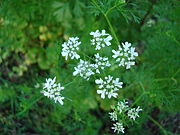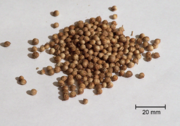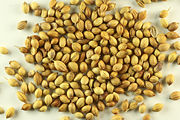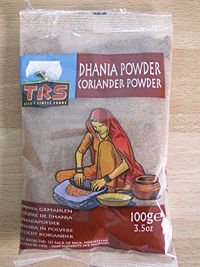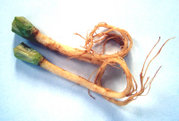Coriander
2008/9 Schools Wikipedia Selection. Related subjects: Food; Plants
| Coriander | ||||||||||||||
|---|---|---|---|---|---|---|---|---|---|---|---|---|---|---|
 |
||||||||||||||
| Scientific classification | ||||||||||||||
|
||||||||||||||
| Binomial name | ||||||||||||||
| Coriandrum sativum L. |
| Coriander leaves, raw Nutritional value per 100 g (3.5 oz) |
|||||||||||
|---|---|---|---|---|---|---|---|---|---|---|---|
| Energy 20 kcal 100 kJ | |||||||||||
|
|||||||||||
| Percentages are relative to US recommendations for adults. |
|||||||||||
Coriander, Coriandrum sativum is an annual herb in the family Apiaceae. The name 'coriander' in a culinary context may refer to either the seeds of the plant (used as a spice), or to its leaves (used as a herb); however, in North American countries the name Cilantro is given to the leaves. Coriander is native to southwestern Asia and west to north Africa. It is a soft, hairless plant growing to 50 cm [20 in.] tall. The leaves are variable in shape, broadly lobed at the base of the plant, and slender and feathery higher on the flowering stems. The flowers are borne in small umbels, white or very pale pink, asymmetrical, and with the petals that point away from the centre of the umbel being longer (5-6 mm) than those pointing to the middle of the umbel (only 1-3 mm long). The fruit is a globular dry schizocarp 3-5 mm diameter.
The name coriander derives from French coriandre through Latin coriandrum in turn from Greek “κορίαννον”. John Chadwick notes the Mycenaean Greek form of the word, koriadnon, "has a pattern curiously similar to the name of Minos' daughter Ariadne, and it is plain how this might be corrupted later to koriannon or koriandron."
Uses
All parts of the plant are edible, but the fresh leaves and the dried seeds are the most commonly used in cooking. Coriander is commonly used in Middle Eastern, Mediterranean, Indian, South Asian, Latin American, Chinese, Vietnamese, African and Southeast Asian cuisine. Gujarati called Dhana.
Leaves and stems
The leaves are variously referred to as coriander leaves in Britain; cilantro (from the Spanish name for the plant) in the United States, and dhania in the Indian subcontinent. The leaves, and especially the stems, have a very different taste from the seeds, similar to parsley but "juicier" and with citrus-like overtones. Some people instead perceive an unpleasant "soapy" taste and/or a rank smell. This is believed to be a result of an enzyme that changes the way they taste coriander leaves, a genetic trait, but has yet to be fully researched.
The fresh leaves and stems are an essential ingredient in many Vietnamese foods, Asian chutneys, Mexican salsas and guacamole, and occasionally is used in sushi rolls. Chopped coriander leaves are also used as a garnish on cooked dishes such as dal and many curries. As heat diminishes their flavor quickly, coriander leaves are often used raw or added to the dish right before serving. In some Indian and Central Asian recipes, coriander leaves are used in huge amounts and cooked till they dissolve into sauce and their flavour mellows. Another factor that dictates the quality of flavor is the time when coriander is harvested. If its roots consistently stay at a temperature above 75 degrees Fahrenheit, the herb will quickly bolt, causing its leaves and stems to yield a bitter flavor and become quite chewy. At this point, made evident by the thinner and finer leaves, it is practical to harvest only the coriander seeds, since the stems and leaves are no longer usable as food.
Coriander leaves were formerly common in European cuisine but nearly disappeared before the modern period. Today Europeans usually eat the leaves and stems only in dishes that originated in foreign cuisines; in Portugal, however, it is still an essential ingredient in many traditional dishes. To use the stems, separate cilantro leaves from stems. Chop stems finely and add them to your dish a minute or two before serving, just giving them time to warm up and disperse their flavor. The leaves will remain beautiful and fresh if you use them to garnish individual plates.
The fresh coriander herb is best stored in the refrigerator in airtight containers, after chopping off the roots. The leaves do not keep well and should be eaten quickly, as they lose their aroma when dried or frozen.
Fruit
The dry fruits are known as coriander seeds or coriandi seeds. In some regions, the use of the word coriander in food preparation always refers to these seeds (as a spice), rather than to the plant itself. The seeds have a lemony citrus flavour when crushed, due to the presence of the terpenes linalool and pinene. It is also described as warm, nutty, spicy, and orange-flavoured. They are usually dried but can be eaten green.
If the fruit is obtained in its natural form, it can later be dried in the sun. Most commonly, it is bought as whole dried seeds, but it can also be found as a powder. When grinding at home, it can be roasted or heated on a dry pan briefly to enhance the aroma before grinding it in an electric grinder or with a mortar and pestle; ground coriander seeds lose their flavour quickly in storage and are best ground as only needed. For optimum flavour, whole coriander seed should be used within six months, or stored for no more than a year in a tightly sealed container away from sunlight and heat.
Coriander seed is a key spice (Hindi name: धनिया dhania) in garam masala and Indian curries, which often employ the ground fruits in generous amounts together with cumin. It also acts as a thickener. Roasted coriander seeds, called dhana dal, are also eaten as a snack. It is also the main ingredient of the two south Indian gravies: sambhar and rasam.
Outside of Asia, coriander seed is an important spice for sausages in Germany and South Africa (see boerewors). In Russia and Central Europe coriander seed is an occasional ingredient in rye bread as an alternative to caraway. Apart from the uses just noted, coriander seeds are rarely used in European cuisine today, though they were more important in former centuries.
Coriander seeds are also used in brewing certain styles of beer, particularly some Belgian wheat beers. The coriander seeds are typically used in conjunction with orange peel to add a sultry citrus character to these styles of beer.
Roots
Coriander roots are used in a variety of Asian cuisine. They are commonly used in Thai dishes.
History
Coriander grows wild over a wide area of the Near East and southern Europe, which forced Zohary and Hopf to admit that "it is hard to define exactly where this plant is wild and where it only recently established itself." Fifteen desiccated mericarps were found in the Pre-Pottery Neolithic B level of the Nahal Hemel Cave in Israel, which may be the oldest archeological find of coriander. About half a litre of coriander mericarps were recovered from the tomb of Tutankhamun, and because this plant does not grow wild in Egypt, Zohary and Hopf interpret this find as proof that coriander was cultivated by the ancient Egyptians. The Bible mentions coriander in Exodus 16:31: "And the house of Israel began to call its name Manna: and it was white like coriander seed, and its taste was like that of flat cakes made with honey."
Coriander seems to have been cultivated in Greece since at least the second millennium BC. One of the Linear B tablets recovered from Pylos refers to the species as being cultivated for the manufacture of perfumes, and it appears that it was used in two forms: as a spice for its seeds and as a herb for the flavour of its leaves. This appears to be confirmed by archaeological evidence from the same period: the large quantities of the species retrieved from an Early Bronze Age layer at Sitagroi in Macedonia could point to cultivation of the species at that time . Coriander is thought to have been introduced to Britain by the Romans as a meat preserver.
Coriander seed and leaf was very widely used in medieval cuisine. Even today, coriander seed is an important ingredient in many sausage products.
Coriander was brought to the British colonies in North America in 1670 and was one of the first spices cultivated by early settlers.
Similar plants
- Eryngium foetidum has a very similar taste to coriander and is also known as culantro.
- Vietnamese coriander leaves have a similar odour and flavour to coriander.
- Bolivian Coriander, or quillquiña, has been described as "somewhere between arugula, cilantro and rue".
Potential medical uses
Coriander has been used as a folk medicine for the relief of anxiety and insomnia in Iranian folk medicine. Experiments in mice support its use as an anxiolytic. Coriander seeds are also used in traditional Indian medicine as a diuretic by boiling equal amounts of coriander seeds and cumin seeds, then cooling and consuming the resulting liquid. In holistic and some traditional medicine, it is used as a carminative and for general digestive aid.
